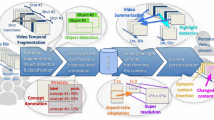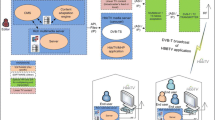Abstract
In this paper we try to identify requirements, opportunities and problems in home media centers and we propose an approach to address them by describing an intelligent home media environment. The major issues investigated are coping with the information overflow in the current provision of TV programs and channels and the need for personalization to specific users by adapting to their age, interests, language abilities, and various context characteristics. The research presented in this paper follows from a collaboration between Eindhoven University of Technology, the Philips Applied Technologies group and Stoneroos Interactive Television. The work has been partially carried out within the ITEA-funded European project Passepartout, which also includes partners like Thomson, INRIA and ETRI. In the following chapter we describe the motivation and research problem in relation to related work, followed by an illustrative use case scenario. Afterwards, we explain our data model which starts with explaining the TV-Anytime structure and its enrichments with semantic knowledge from various ontologies and vocabularies. The data model description then serves as the background for understanding our proposed system architecture SenSee. Afterwards we go deeper into the user modeling part and explain how our personalization approach works. The latter elaborates on a design targeting interoperability and on semantic techniques for enabling intelligent context-aware personalization. In the implementation chapter we describe some practical issues as well as our main interface showcase, iFanzy. Future work and conclusions end this chapter.
Access this chapter
Tax calculation will be finalised at checkout
Purchases are for personal use only
Similar content being viewed by others
Notes
- 1.
- 2.
- 3.
- 4.
- 5.
- 6.
- 7.
- 8.
- 9.
- 10.
- 11.
- 12.
- 13.
- 14.
- 15.
- 16.
- 17.
- 18.
- 19.
References
H. Alshabib, O. F. Rana, and A. S. Ali. Deriving ratings through social network structures. In ARES ’06: Proceedings of the First International Conference on Availability, Reliability and Security, pages 779–787, Washington, DC, USA, 2006. IEEE Computer Society
L. Ardissono, A. Kobsa, M. Maybury (ed) (2004) Personalized digital television: targeting programs to individual viewers. Kluwer, Boston
P. Bellekens, L. Aroyo, G.J. Houben, A. Kaptein, K. van der Sluijs, “Semantics-Based Framework for Personalized Access to TV Content: The iFanzy Use Case”, Proceedings of the 6th International Semantic Web Conference, pp. 887–894, LNCS 4825, Springer, Busan, Korea (2007)
S.J. Berman (2004) Media and entertainment 2010. Open on the inside, open on the outside: The open media company of the future. Retrieved November 24, 2005, from http://www-03.ibm.com/industries/media/doc/content/bin/ME2010.pdf
T. Berners-Lee, J. Hendler, O. Lassila (2001) The semantic web. Scientific American, New York
J. Bormans, K. Hill (2002) MPEG-21 Overview v.5. Retrieved November 24, 2005, from http://www.chiariglione.org/mpeg/standards/mpeg-21/mpeg-21.htm
K. Chorianopoulos (2004) What is wrong with the electronic program guide. Retrieved November 24, 2005, from http://uitv.info/articles/2004/04chorianopoulos
N. Earnshaw, S. Aoki, A. Ashley, W. Kameyama (2005) The TV-anytime Content Reference Identifier (CRID). Retrieved November 24, 2005, from http://www.rfc-archive.org/getrfc.php?rfc=4078
B. de Ruyter, E. Aarts (2004) Ambient intelligence: visualizing the future. In: Proceedings of the working conference on advanced visual interfaces. ACM, New York, pp 203–208
D. Goren-Bar, O. Glinansky (2004) FIT-recommending TV programs to family members. Comput Graph 28: 149–156 (Elsevier)
J. Hobbs, F. Pan (2004) An ontology of time for the semantic web. In: ACM Transactions on Asian Language Information Processing (TALIP), vol 3, Issue 1. ACM, New York
B. Hong, J. Lim (2005) Design and implementation of home media server using TV-anytime for personalized broadcasting service. In: O. Gervasi, M.L. Gavrilova, V. Kumar, A. Laganà, H.P. Lee, Y. Mun, D. Taniar, C.J.K Tan (eds) Computational science and its applications—-ICCSA 2005: conference proceedings, part IV, vol 3483. LNCS. Springer, Berlin Heidelberg New York, pp 138–147
A. Kobsa (1990) User modeling in dialog systems: potentials and hazards. AI Soc 4(3): 214–231 (Springer-Verlag London Ltd)
F. Manola, E. Miller (2004) RDF Resource Description Framework. Retrieved November 24, 2008, http://www.w3.org/TR/rdf-primer/
J. Masthoff (2004) Group modeling: selecting a sequence of television items to suit a group of viewers. User Model User-Adapt Interact 14: 37–85 (Kluwer)
D.L. McGuinnes, F. van Harmelen (2004) OWL Web Ontology Language. Retrieved November 24, 2008, from http://www.w3.org/TR/owl-features
G.A. Miller (1995) WordNet: a lexical database for english. Commun ACM 38(11) (ACM)
S. Murugesan, Y. Deshpande (2001) Web engineering, software engineering and web application development. In: S. Murugesan, Y. Deshpande (eds) Web engineering, vol 2016. Lecture notes in computer science. Springer, Berlin Heidelberg New York
C.B. Necib, J.-C. Freytag (2005) Query processing using ontologies. In: O. Pastor, J.F. Cunha (eds) Advanced information systems engineering: 17th international conference, CAiSE 2005, vol 3520. Lecture notes in computer science. Springer, Berlin Heidelberg New York, pp 167–186
D. O’ Sullivan, B. Smith, D. Wilson, K. McDonald, A. Smeaton (2004 Improving the quality of personalized electronic program guide. User Model User-Adapt Interact 14: 5–36 (Kluwer)
M.J. Pazzani (1999) A framework for collaborative, content-based and demographic filtering. Artif Intell Rev 13:393–408
U. Shardanand, P. Maes (1995) Social information filtering: algorithms for automating “Word of Mouth”. In: CHI ’95 Proceedings: conference on human factors in computing systems. pp 210–217
G. Stamou, J. van Ossenbruggen, J.Z. Pan, G. Schreiber (2006) In: J.R. Smith (ed) Multimedia annotations on the semantic Web. IEEE Multimed 13(1):86–90
M. van Setten (2005) Supporting people in finding information: hybrid recommender systems and goalbased structuring. Telematica Instituut fundamental research Series, No. 016 (TI/FRS/016). Universal, The Netherlands
H.-W. Tung and V.-W. Soo. A personalized restaurant recommender agent for mobile e-service. In EEE ’04: Proceedings of the 2004 IEEE International Conference on e-Technology, e-Commerce and e-Service (EEE’04), pages 259–262, Washington, DC, USA, 2004. IEEE Computer Society
W. Woerndl and G. Groh. Utilizing physical and social context to improve recommender systems. In WI-IATW ’07: Proceedings of the 2007 IEEE/WIC/ACM International Conferences on Web Intelligence and Intelligent Agent Technology - Workshops, pages 123–128, Washington, DC, USA, 2007. IEEE Computer Society
G.-E. Yap, A.-H. Tan, and H.-H. Pang. Dynamically-optimized context in recommender systems. In MDM ’05: Proceedings of the 6th international conference on Mobile data management, pages 265–272, New York, NY, USA, 2005. ACM.
Z. Yu, X. Zhou (2004) TV3P: an adaptive assistant for personalized TV. IEEE Transactions on Consumer Electronics 50 (1):393–399
Author information
Authors and Affiliations
Corresponding author
Editor information
Editors and Affiliations
Rights and permissions
Copyright information
© 2009 Springer Science+Business Media, LLC
About this chapter
Cite this chapter
Bellekens, P., Aroyo, L., Houben, GJ. (2009). Semantic-Based Framework for Integration and Personalization of Television Related Media. In: Furht, B. (eds) Handbook of Multimedia for Digital Entertainment and Arts. Springer, Boston, MA. https://doi.org/10.1007/978-0-387-89024-1_3
Download citation
DOI: https://doi.org/10.1007/978-0-387-89024-1_3
Published:
Publisher Name: Springer, Boston, MA
Print ISBN: 978-0-387-89023-4
Online ISBN: 978-0-387-89024-1
eBook Packages: Computer ScienceComputer Science (R0)




